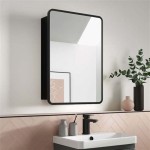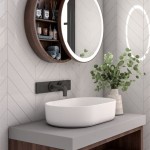Bathroom Mirror LED Light Replacement: A Comprehensive Guide
Bathroom mirrors with integrated LED lighting have become increasingly popular due to their energy efficiency, sleek aesthetic, and enhanced illumination. However, like any electrical component, the LED lights within these mirrors can eventually fail, requiring replacement. This article provides a detailed guide on how to replace LED lights in a bathroom mirror, covering essential considerations, necessary tools, and step-by-step instructions.
Before embarking on the replacement process, it is paramount to understand the specific configuration of the LED lighting system within the mirror. Different manufacturers utilize various LED strip designs, power supplies, and wiring schematics. Therefore, careful observation and documentation of the existing setup are crucial for a successful replacement.
Safety is also a critical factor. Working with electrical components requires adherence to safety precautions to prevent electrical shock. Disconnecting the power supply to the mirror and wearing appropriate personal protective equipment (PPE) are non-negotiable steps.
Understanding the LED Lighting System
The LED lighting system in a bathroom mirror typically consists of several key components: the LED strip itself, the power supply (also known as a driver), and the wiring connecting these components. The LED strip is the source of light and consists of multiple LEDs mounted on a flexible circuit board. The power supply converts the household AC voltage (e.g., 120V or 240V) to a low DC voltage suitable for the LEDs (typically 12V or 24V). The wiring provides the electrical pathway for the current to flow from the power supply to the LED strip.
LED strips are available in various types, including single-color, color-changing (RGB), and adjustable color temperature (CCT) options. The type of LED strip used in the mirror will determine the complexity of the replacement process and the type of replacement strip needed. Identifying the type of LED strip is essential before purchasing a replacement. This information can sometimes be found on the original strip itself, in the mirror's documentation, or by contacting the manufacturer.
The power supply is another critical component. It is important to note its input and output voltage ratings, as well as its maximum power output. Replacing the power supply with one that does not match the original specifications can damage the LED strip or create a fire hazard. The power supply's specifications are usually printed on its casing.
Furthermore, the wiring configuration should be carefully examined and documented. Take pictures or draw a diagram of how the wires are connected to the LED strip and the power supply. This will be invaluable during the reassembly process. Note the polarity of the wires (positive and negative) to ensure correct connection of the new LED strip.
Essential Tools and Materials
To successfully replace the LED lights in a bathroom mirror, the following tools and materials are typically required:
*Screwdrivers:
A set of screwdrivers with various head types (Phillips, flathead) is necessary for disassembling the mirror and accessing the LED components. *Wire stripper:
A wire stripper is used to remove the insulation from the wires without damaging the conductors. *Wire cutter:
A wire cutter is used to cut wires to the appropriate length. *Multimeter:
A multimeter is a valuable tool for testing the voltage and continuity of the electrical circuits. It can be used to verify that the power supply is functioning correctly and that the wiring is intact. *Electrical tape or wire connectors:
These are used to insulate and connect the wires safely. Wire connectors, such as Wago connectors, provide a more secure and reliable connection than electrical tape. *Soldering iron and solder (optional):
Soldering provides a more permanent and reliable connection than wire connectors, but it requires experience and skill. *Heat shrink tubing (optional):
Heat shrink tubing provides a protective and insulated covering for soldered connections. *Replacement LED strip:
This is the new LED strip that will replace the old one. Ensure that it is compatible with the existing power supply and wiring. *Replacement power supply (if necessary):
If the power supply is faulty, it will need to be replaced with a compatible unit. *Safety glasses:
Safety glasses protect the eyes from debris and electrical sparks. *Gloves:
Insulated gloves protect the hands from electrical shock. *Voltage tester:
A non-contact voltage tester can be used to verify that the power is disconnected before working on the electrical components.Step-by-Step Replacement Process
The following steps provide a general guideline for replacing LED lights in a bathroom mirror. However, it is essential to consult the mirror's specific instructions and exercise caution throughout the process.
Disconnect the Power:
The most critical step is to disconnect the power supply to the mirror. Locate the circuit breaker that controls the mirror's electrical circuit and turn it off. Use a non-contact voltage tester to verify that the power is indeed disconnected before proceeding.Disassemble the Mirror:
Carefully disassemble the mirror to access the LED lighting system. This may involve removing screws, clips, or other fasteners. Refer to the mirror's documentation or online resources for specific instructions. Take pictures or videos of the disassembly process to aid in reassembly.Locate the LED Strip and Power Supply:
Once the mirror is disassembled, locate the LED strip and power supply. They are typically located on the back of the mirror or within a housing.Inspect the Wiring and Connections:
Examine the wiring and connections for any signs of damage, such as frayed wires, loose connections, or corrosion. These issues may need to be addressed before installing the new LED strip.Remove the Old LED Strip:
Carefully remove the old LED strip. This may involve peeling it off the mirror surface or unscrewing it from a mounting bracket. If the LED strip is glued to the mirror, use a heat gun or hairdryer to soften the adhesive before attempting to remove it. Avoid damaging the mirror surface during removal.Prepare the Surface:
Clean the surface where the new LED strip will be mounted. Remove any adhesive residue or debris. Use a clean cloth and a mild cleaning solution. Ensure that the surface is dry before proceeding.Install the New LED Strip:
Attach the new LED strip to the prepared surface. If the LED strip has an adhesive backing, peel off the protective layer and carefully apply the strip to the surface. Ensure that the strip is properly aligned and securely attached. If the LED strip requires screws or clips, use the appropriate hardware to secure it in place.Connect the Wiring:
Connect the wiring to the new LED strip. Match the polarity of the wires (positive and negative) to the corresponding terminals on the LED strip. Use wire connectors or solder to create secure and insulated connections. If using wire connectors, ensure that the wires are properly inserted and tightened. If soldering, use heat shrink tubing to insulate the connections. Refer to the wiring diagram or pictures taken during disassembly to ensure correct connections.Replace the Power Supply (if necessary):
If the power supply is faulty, replace it with a compatible unit. Disconnect the wiring from the old power supply and connect the wiring to the new power supply. Ensure that the input and output voltage ratings of the new power supply match the original specifications. Secure the new power supply in its housing.Test the LED Lights:
Before reassembling the mirror, test the LED lights to ensure that they are working correctly. Turn on the circuit breaker and observe the LED strip. If the lights do not turn on, check the wiring connections and the power supply. Use a multimeter to verify that the power supply is providing the correct voltage.Reassemble the Mirror:
Carefully reassemble the mirror, following the reverse order of disassembly. Ensure that all screws, clips, and fasteners are securely tightened.Final Test:
Once the mirror is reassembled, turn on the circuit breaker and perform a final test of the LED lights. Verify that the lights are working correctly and that there are no loose connections or other issues.
Troubleshooting Common Issues
Despite careful preparation and execution, issues may arise during or after the LED light replacement process. Here are some common problems and potential solutions:
*LED lights do not turn on:
This could be due to a faulty power supply, loose wiring connections, or a damaged LED strip. Check the power supply voltage with a multimeter. Verify that all wiring connections are secure and properly insulated. If the LED strip is damaged, it will need to be replaced. *LED lights flicker or dim:
This could be caused by a loose wiring connection, a failing power supply, or a faulty LED strip. Check the wiring connections and tighten any loose connections. Replace the power supply if it is failing. If the LED strip is faulty, it will need to be replaced. *LED lights are the wrong color:
This could be due to incorrect wiring connections or a faulty LED strip. Verify that the wiring connections are correct and that the polarity of the wires is properly matched. If the LED strip is faulty, it will need to be replaced. *Power supply is overheating:
This could be due to an overloaded power supply or inadequate ventilation. Ensure that the power supply is not overloaded and that it has adequate ventilation. Replace the power supply with a higher-capacity unit if necessary. *Mirror is damaged during disassembly or reassembly:
Exercise caution during disassembly and reassembly to avoid damaging the mirror. Use the appropriate tools and techniques. If the mirror is damaged, it may need to be repaired or replaced.Replacing LED lights in a bathroom mirror requires careful planning, attention to detail, and adherence to safety precautions. By understanding the LED lighting system, using the appropriate tools and materials, and following the step-by-step instructions, it is possible to successfully replace the LED lights and restore the functionality and aesthetics of the bathroom mirror.

Es Diy 24 In W X 32 H Rectangular Frameless Led Light And Anti Fog Wall Bathroom Vanity Mirror Matte White Hoy1rebm2432vc The Home Depot

Homlux 36 In W X H Round Frameless Led Light With 3 Color And Anti Fog Wall Mounted Bathroom Vanity Mirror 27d7004792 The Home Depot

Homlux 32 In W X H Round Frameless Led Light With 3 Color And Anti Fog Wall Mounted Bathroom Vanity Mirror 96fb004795 The Home Depot

Led Vanity Mirror Full Length With 22 Dimmable Light Bulbs Modern Floor Hanging Or Leaning Touch Control Wall Mounted Whole Dressing 3 Modes For Bedroom Silver Com

Homlux 32 In W X H Round Frameless Led Light With 3 Color And Anti Fog Wall Mounted Bathroom Vanity Mirror 96fb004795 The Home Depot

Replacing A Light Fixture On Vanity Mirror

Best Lighted Bathroom Mirrors To Buy In 2024

Homlux 36 In W X H Round Frameless Led Light With 3 Color And Anti Fog Wall Mounted Bathroom Vanity Mirror 27d7004792 The Home Depot

White Hollywood Makeup Mirror With Lights Dimmable Large Vanity Vonluce

Torchstar 12 Pack Vanity Globe Light Bulbs G25 Led For Bathroom Mirror Decorative 6w Equivalent 40w Ul Energy Star Listed Dimmable 450 Lm E26 Round Frosted Bulb 2700k Soft White








